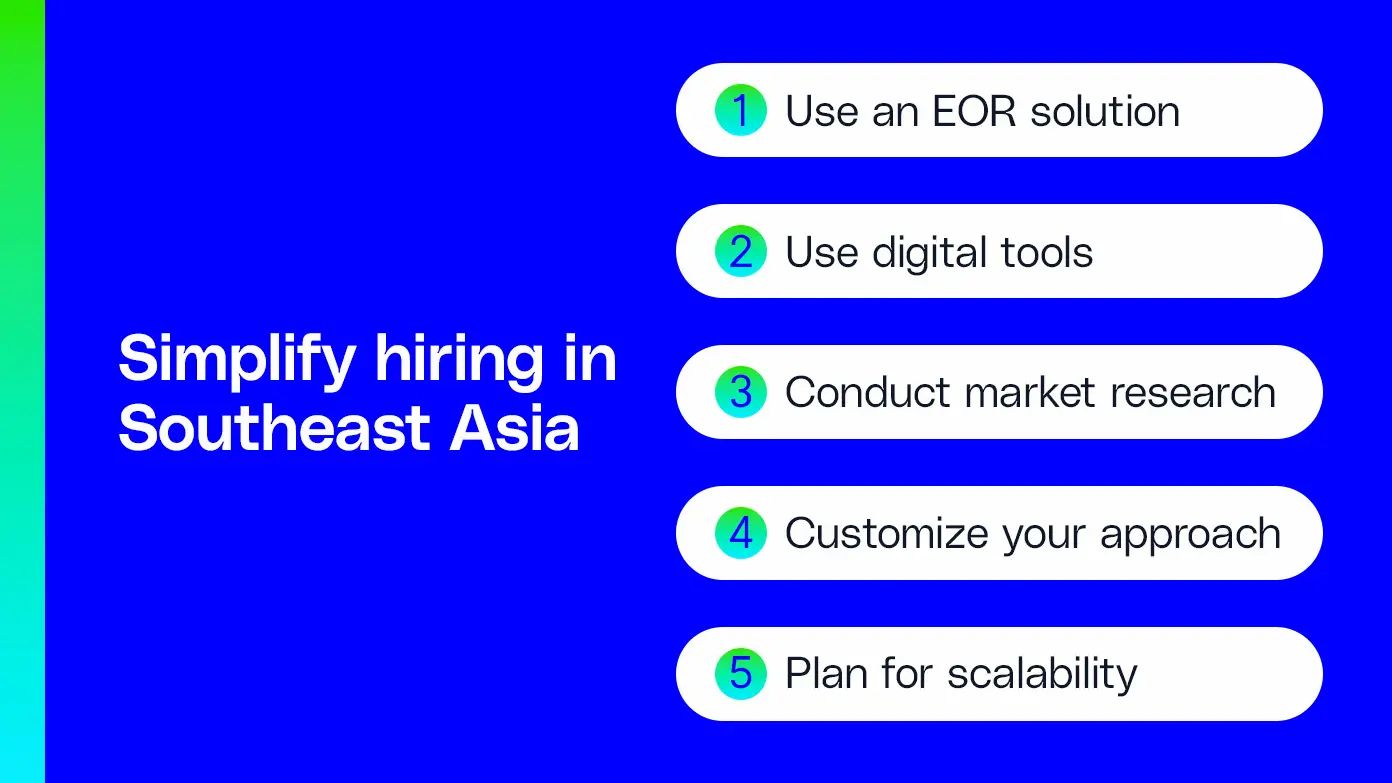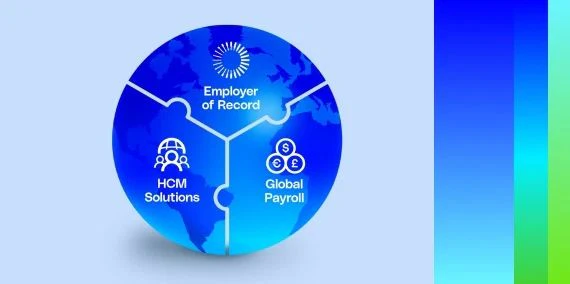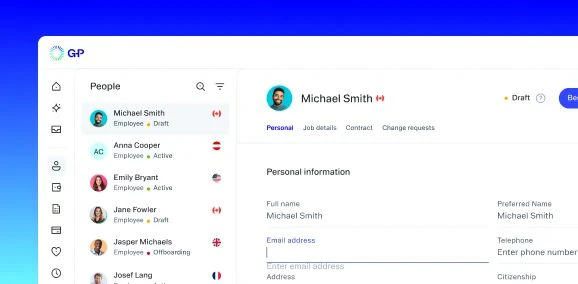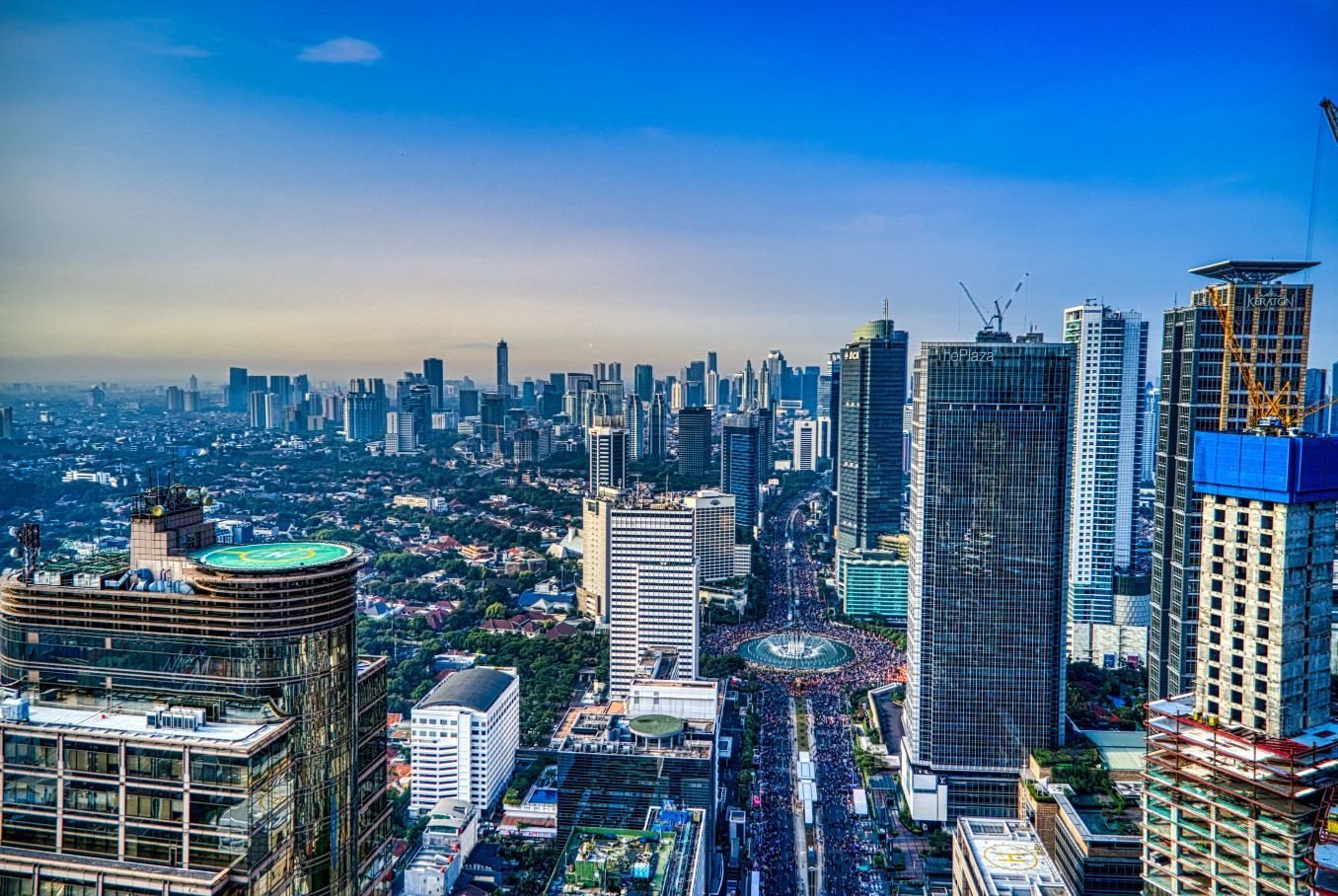Southeast Asia offers the global market resilient supply chains, a connected consumer base, and diverse talent pools. With a smart global employment strategy, you can take advantage of these opportunities and move fast while protecting your business from financial and compliance risks.
Let's explore six countries with attractive business opportunities, plus hiring tips to build a dynamic workforce that grows with you.
Why expand into Southeast Asia?
The member countries of the Association of Southeast Asian Nations (ASEAN) are home to over 670 million people. Estimates anticipate 140 million new consumers in Southeast Asia by 2030. These large talent and consumer markets support business stability. Proximity to major supply bases and dense shipping lanes also shortens lead times and lowers logistics risk.
Different industries in Southeast Asia are attracting global investors, particularly sectors like technology and data infrastructure, manufacturing and electronics, e‑commerce and payments, healthcare, and renewables.
Southeast Asia's labor market potential is undeniable. Companies that expand into the region can expect:
-
Market growth and diversification: Multiple demand centers reduce reliance on a single country. You can balance revenue across mature hubs like Singapore and fast‑growing markets like Vietnam and the Philippines.
-
Talent availability: Large, tech‑savvy talent pools support engineering, operations, finance, and customer roles. Strong English proficiency and a culture of upskilling allow for fast and cost-efficient hiring.
-
Strategic location: The region sits near China and benefits from free‑trade frameworks like the Regional Comprehensive Economic Partnership (RCEP). This supports cross-border sales within Asian and global markets and improves lead times for supplies. The region supports a hub‑and‑spoke model where, for example, you can operate in Singapore, produce in Vietnam or Thailand, and sell across the region.
-
Regulatory alignment: While rules differ by country, legal teams can standardize core policies based on ASEAN norms and then adapt contracts, payroll, and benefits to local law.
The top 6 countries in Southeast Asia for global expansion
If you’re ready to tap into Southeast Asia's talent pool, here are six countries worth looking into.
1. Singapore
Singapore offers strong IP protection and fast licensing, which helps companies start operations quickly. Hiring senior talent is straightforward under the COMPASS framework for Employment Passes. The country's logistics network, including the Port of Singapore and Changi Airport, supports time‑sensitive operations.
Operating costs are higher than in other ASEAN countries, but deep financial markets and an extensive free trade agreement network, including the RCEP, can help offset them. Many companies operate in Singapore and place cost‑sensitive teams in nearby markets.
2. Malaysia
Malaysia combines skilled, English‑proficient talent with competitive costs and extensive data infrastructure.
Businesses operating in Malaysia must manage personal data under the Personal Data Protection Act. Investment approvals run through the Malaysian Investment Development Authority, with targeted incentives for priority sectors. Companies must plan for statutory contributions to:
-
The Employee Provident Fund
-
The Social Security Organization
-
The Employment Insurance System
Kuala Lumpur and Penang offer experienced engineering and finance teams, while Johor provides proximity to Singapore with lower real estate and labor expenses.
3. Indonesia
Indonesia's large, growing population makes it an attractive market. The Positive Investment List has opened more sectors to international ownership.
HR teams should account for:
-
Provincial minimum wages
-
Badan Penyelenggara Jaminan Sosial health and employment program contributions
-
Detailed employment rules, including the overtime cap of four hours per day or 18 hours per week
Companies expanding to Indonesia should have risk management plans, strong payroll controls, and in‑country legal guidance.
4. Vietnam
Vietnam is a manufacturing and tech vendor hub for electronics, apparel, and device assembly. Competitive wages and improving infrastructure attract foreign direct investment. Hanoi and Ho Chi Minh City provide growing engineering and operations talent. Before you make the move to Vietnam, make sure to research compulsory social, health, and unemployment insurance, overtime limits, and union engagement.
G-P Gia™, our AI-powered global HR agent, can give you instant expert guidance. It can answer your toughest compliance questions across 50 countries — including Vietnam — and all 50 U.S. states.
5. Thailand
Thailand has strong automotive, electronics, and food processing sectors and is well-connected to the wider region. The Board of Investment provides tax holidays and visa facilitation for approved projects, and the Eastern Economic Corridor focuses on incentives for advanced industry.
Employers contribute to the Social Security Fund and follow a structured severance schedule based on tenure.
6. Philippines
The Philippines is a leader in information technology and business process management (IT-BPM) and customer operations. The country has high English proficiency rates and a large workforce. Payroll requirements include:
-
Mandatory 13th-month salary
-
Social security contributions
-
Philippine Health Insurance Corporation contributions
-
Home Development Mutual Fund contributions
-
Night shift and holiday premiums
With the right technology, country-specific guidance, and consistent processes, companies can hire quickly and compliantly across these ASEAN countries.
How to simplify hiring in Southeast Asia

These tips will help you hire in Southeast Asia:
-
Use an EOR solution: Hire employees in your target country without setting up a subsidiary by partnering with an employer of record (EOR). An EOR can ensure full compliance with local labor laws and tax regulations.
-
Use digital tools: Choose a user-friendly global employment platform to streamline hiring, payroll, benefits, and workforce management.
-
Conduct market research: Assess each country's business environment, talent pool, and regulatory landscape with an AI-powered global HR agent like Gia.
-
Customize your approach: Tailor employment contracts, benefits, and HR policies to local expectations.
-
Plan for scalability: Start with one or two countries, and then expand over time.
Factors to consider before expanding into Southeast Asia
Consider these factors before expanding into Southeast Asia:
-
Workforce availability and skills: Choose a market with the skills you need to meet your goals. For example, the Philippines' IT-BPM sector is on track to employ 2.5 million people, indicating a strong supply of skills in these areas. An EOR that knows the local environment can help you conduct a cost-benefit analysis to compare opportunities across ASEAN countries.
-
Ease of doing business: Corporate tax rates, baseline employment benefits, and costs of doing business in Southeast Asia vary between countries.
-
Market entry strategy: Setting up a local entity can be time-consuming, expensive, and risky. An EOR helps you hire, streamline payroll and benefits, and comply with local labor laws — no entity needed.
Build your global team with G-P™
As the recognized leader in global employment, G-P helps companies of all sizes hire, onboard, and manage global teams in 180+ countries, regardless of entity status. Our AI-powered global employment products and EOR solutions are backed by the largest team of in-country HR, legal, and compliance experts to streamline and simplify the entire global employment lifecycle.
Contact us today to expand your business to Southeast Asia.





















